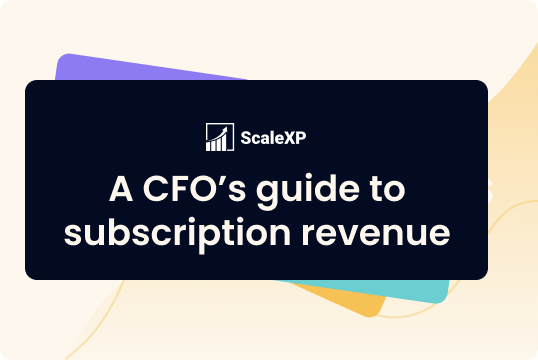As a CFO in the SaaS world, you know revenue isn’t just about money coming in. It’s about the when, how, and why. You’re constantly dealing with evolving contracts, upgrades, downgrades, usage-based pricing, and shifting compliance rules. Traditional accounting tools simply can’t keep up.
This guide breaks down the essentials of SaaS accounting, helping you accurately recognise revenue, stay compliant, and scale with confidence. Whether you’re preparing for an audit, fundraising, or just want cleaner financials, this is for you.
Understanding the Unique Challenges of SaaS Revenue Accounting
SaaS companies thrive on a recurring revenue model, which introduces complexities traditional businesses don’t face. You’re not just recording a sale; you’re spreading revenue across months, managing deferred income, and handling customer changes in real-time.
For finance leaders, this means:
- Revenue recognition isn’t straightforward. You must match performance obligations with contract terms.
- Cash flow and revenue don’t align. You might invoice upfront, but can only recognise revenue as services are delivered.
- Metrics drive strategy. ARR, MRR, and churn aren’t just buzzwords—they shape valuation and board conversations.
To get this right, you need systems that go beyond the general ledger. You need clarity, consistency, and ideally, automation.
Navigating ASC 606 and IFRS 15
Accounting standards have evolved to better reflect subscription models. ASC 606 (US GAAP) and IFRS 15 (international) now guide how SaaS companies recognise revenue. Both follow the same five-step framework:
The Five-Step Model
- Identify the contract: What’s the agreement between your company and the customer?
- Identify performance obligations: Is it just the subscription? What about onboarding, support, or other services?
- Determine the transaction price: Are there discounts, incentives, or variable fees?
- Allocate the price to obligations: Split the revenue across each deliverable in the contract.
- Recognise revenue: Log revenue as each performance obligation is fulfilled—not when you’re paid.
This can feel like a long process, but the core principal is very simple. When are the services provided? Revenue should be allocated in accordance with this.
Real-World Examples
Let’s say you sell an annual SaaS subscription with a £12,000 upfront invoice. Under ASC 606 or IFRS 15, that income can’t be recognised immediately. It must be recognised over 12 months as the service is delivered.
Now add onboarding fees, tiered pricing, or usage-based add-ons, and it gets more complex. Each component needs to be broken out, tracked separately, and recognised at the right time. This is where most finance teams run into trouble—especially if they’re relying on spreadsheets.
Deferred Revenue, Accruals, and Revenue Recognition Over Time
In SaaS accounting, revenue rarely aligns with cash. Just because you’ve invoiced a customer doesn’t mean you’ve earned that revenue. That’s where deferred revenue and accrual accounting come into play.
What is Deferred Revenue?
Deferred revenue—also known as unearned revenue—is the amount you’ve billed in advance for services you haven’t yet delivered. It sits on your balance sheet as a liability, not revenue, until those services are provided.
For example:
- A customer pays £24,000 upfront for a 12-month contract in January.
- You recognise £2,000 per month as revenue.
- The remaining balance stays as deferred revenue until each month passes.
This ensures your income statement reflects performance, not cash movement—a core principle of accrual accounting.
Why It Gets Complicated
Tracking deferred revenue manually becomes a nightmare as your customer base grows, especially when:
- Contracts start and end mid-month
- Customers upgrade or downgrade services
- Discounts or variable pricing apply
- Multi-element contracts include onboarding, training, or usage tiers
Each of these scenarios requires careful tracking to stay audit-compliant and accurate.
The Fix: Automation and Control
Deferred revenue schedules, revenue waterfalls, and monthly journal entries shouldn’t require hours in spreadsheets. Modern finance teams are shifting to automated solutions that:
- Track contract changes in real-time
- Auto-calculate earned vs. unearned revenue
- Feed data directly into your general ledger
- Provide clear audit trails and compliance reports
- Allow you to build your MRR from this information with the flexibility to tailor calculations for your business and a clear audit trail back to invoices.
ScaleXP makes this seamless. It connects to your accounting system, automates revenue recognition under ASC 606 or IFRS 15, and gives you complete visibility into your financial performance—without spreadsheet chaos. You can even see how your IFRS journals tie to your MRR – customer by customer and invoice by invoice.
How Hybrid Pricing is Changing the Game
Subscription-only models used to dominate SaaS. But today, many companies are shifting to hybrid pricing—a mix of subscriptions, usage-based billing, professional services, and even one-off fees. It’s more flexible for customers and better aligned with value delivered, but it introduces real complexity for finance teams.
Combining Subscriptions, Usage, Services, and even Bundles
Let’s say your company offers:
- A monthly subscription for core platform access
- Usage-based charges for API calls or storage
- A one-time onboarding fee for new customers
- Optional professional services charged at a day rate
- And a bundle for an old product and service which is no longer sold
Each of these revenue streams has different recognition rules under ASC 606 / IFRS 15. Subscriptions are recognised over time, usage fees may be variable and recognised as incurred, and services may be tied to separate performance obligations. The more flexible your pricing, the more important it is to track and separate these elements accurately.
CFO Strategies for Adapting
To stay ahead, finance leaders are rethinking their processes in three key ways:
- Segmenting revenue streams: Identify and track each component of your contract separately—subscriptions, usage, services—from quote to cash.
- Automating recognition logic: Manual calculations won’t scale. Use tools that can apply the right recognition rules to each line item automatically.
- Creating transparency with clear schedules for IFRS journals and for MRR or ARR – broken down by product, GL code, even customer.
This is exactly where ScaleXP helps. Our platform handles complex, hybrid SaaS models effortlessly—syncing directly with Xero QuickBooks and ZohoBooks to automate revenue recognition and give you clarity across every stream.
Interested in learning more but not quite ready to commit? Book a short meeting to discuss your requirements in greater detail. Even a short conversation can be helpful in seeing what’s out there and how it might fit your needs.


